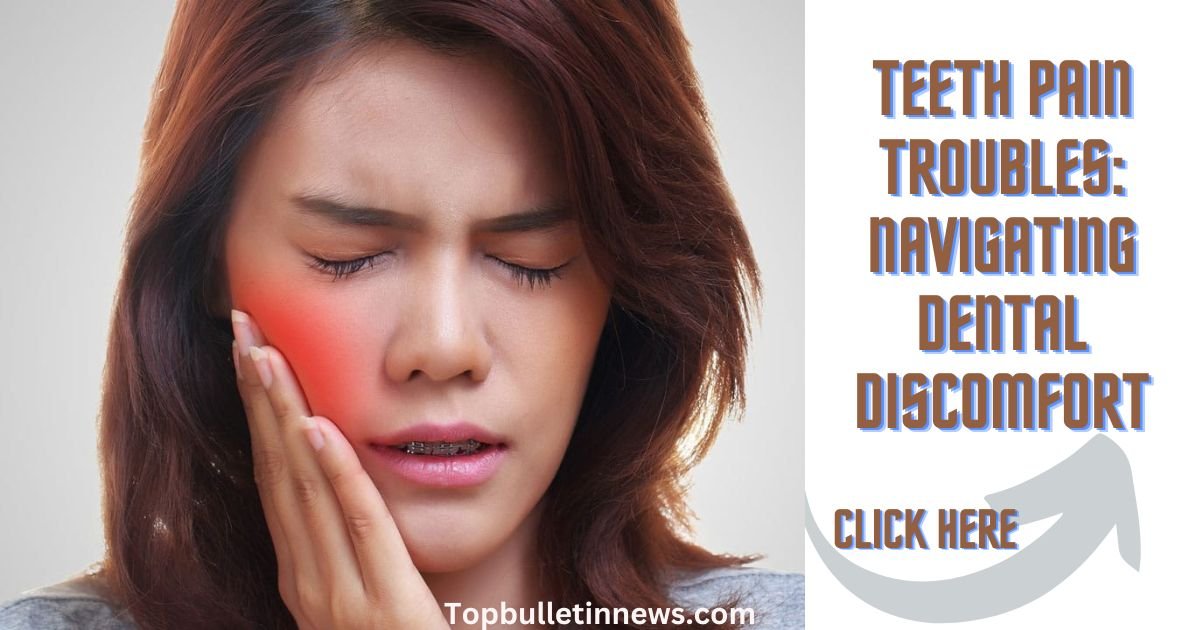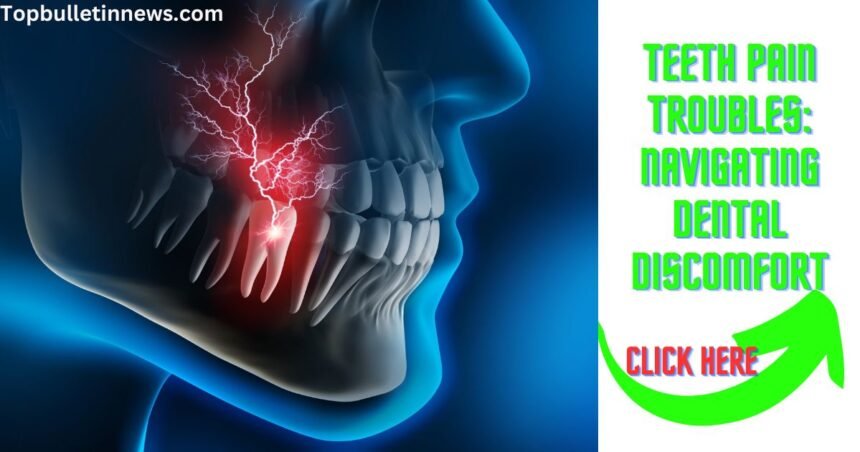Toothache, an unpleasant sensation that varies from mild annoyance to excruciating torment, plagues individuals of all ages as a prevalent dental woe. Whether it manifests as a dull throb, sudden jolt, or relentless pulsing, tooth pain can severely disrupt daily routines and diminish life’s enjoyment. Acquiring insights into its origins, signs, and effective coping mechanisms is vital for safeguarding oral health and holistic wellness.
Causes of Teeth Pain
Here are some human-friendly points outlining the causes of teeth pain:
- Tooth Decay: When bacteria in plaque produce acids that eat away at tooth enamel, it leads to decay, exposing nerves and causing pain.
- Gum Disease: Infections and inflammation of the gums can result in sensitivity and pain around the teeth.
- Cracked or Fractured Teeth: Chips, cracks, or fractures in the teeth can expose sensitive nerves, causing sharp pain.
- Dental Abscesses: Pus-filled pockets caused by bacterial infection in the tooth or gums can lead to severe, throbbing pain.
- Sinus Infections: Sometimes, pain in the upper teeth can be a result of sinus congestion or infection, as the sinuses are located close to the roots of the upper molars.
- Grinding Teeth (Bruxism): Habitual teeth grinding or clenching can wear down tooth enamel and lead to tooth sensitivity and pain.
- Trauma: Accidents or injuries to the mouth or jaw can cause damage to teeth, resulting in pain.
- Orthodontic Treatment: In some cases, orthodontic appliances or braces can cause temporary discomfort or pain as the teeth shift positions.
- Temperature Sensitivity: Sensitivity to hot or cold foods and drinks can indicate enamel erosion or dental issues, causing discomfort.
- Impacted Wisdom Teeth: When wisdom teeth do not have enough space to emerge properly, they can become impacted, causing pain and swelling in the surrounding gums.

Deciphering the Symptoms: Signs of Teeth Pain
Here are some user-friendly points highlighting the signs of teeth pain:
- Persistent Ache or Throbbing: Feeling a continuous dull or throbbing pain in or around a tooth can indicate underlying issues.
- Sharp, Sudden Pain: Experiencing sudden, sharp bursts of pain when biting down or chewing could signal a cracked tooth or dental injury.
- Increased Sensitivity: Sensitivity to hot, cold, sweet, or sour foods and drinks, especially when the sensation lingers, may indicate tooth decay or enamel erosion.
- Swelling and Redness: Swelling and redness around the gums or a specific tooth could be a sign of infection or abscess.
- Pain When Eating or Drinking: Discomfort or pain while eating or drinking, particularly with pressure on a specific tooth, might indicate a cavity, fracture, or other dental issue.
- Pain with Touch: Feeling pain or tenderness when touching or applying pressure to a specific tooth or area of the mouth can be a sign of infection or inflammation.
- Headaches or Jaw Pain: Chronic headaches or jaw pain, especially in the morning, could be related to teeth grinding (bruxism) or misaligned teeth causing strain on the jaw muscles.
- Bad Breath or Unpleasant Taste: Persistent bad breath or a foul taste in the mouth, even after brushing, might be a sign of an underlying dental infection.
- Visible Damage: Seeing visible signs of damage such as chips, cracks, or discoloration on a tooth can indicate potential issues causing pain.
- Difficulty Opening Mouth: Difficulty opening the mouth fully or pain while opening or closing it could be a sign of temporomandibular joint (TMJ) disorder or dental problems.
Confronting the Pain: Management Strategies
Managing teeth pain often involves a combination of self-care measures, home remedies, and professional dental interventions. Here are some strategies to alleviate discomfort and promote oral health:
- Mind-Body Techniques: Incorporating mindfulness and relaxation techniques can help manage teeth pain by reducing stress levels, which can exacerbate pain perception. Techniques such as deep breathing, meditation, and progressive muscle relaxation can help alleviate discomfort and promote overall well-being.
- Acupressure and Acupuncture: Traditional Chinese medicine practices like acupressure and acupuncture can be effective complementary approaches to managing teeth pain. By stimulating specific points on the body, these techniques may help relieve pain and improve circulation, promoting healing.
- Herbal Remedies: Some herbal remedies, such as clove oil, peppermint oil, or chamomile tea, have natural analgesic properties that can provide temporary relief from teeth pain. These remedies can be used topically or orally to soothe discomfort and reduce inflammation.
- Cold Therapy: Applying a cold compress or ice pack to the affected area can help numb the nerves and reduce swelling, providing temporary relief from teeth pain. Cold therapy can also constrict blood vessels, which may help alleviate pain associated with inflammation or tooth sensitivity.
- Probiotics: Emerging research suggests that probiotics may play a role in oral health by promoting a healthy balance of bacteria in the mouth. Incorporating probiotic-rich foods or supplements into your diet could potentially help reduce the risk of dental issues that may lead to teeth pain, such as cavities or gum disease.
- Aromatherapy: Certain essential oils, such as lavender or eucalyptus oil, have analgesic and anti-inflammatory properties that can help alleviate teeth pain. Inhalation or topical application of these oils may provide relief and promote relaxation, contributing to overall pain management.
- Dietary Adjustments: Consuming a diet rich in vitamins, minerals, and antioxidants can support overall oral health and reduce the risk of teeth pain. Avoiding sugary and acidic foods and beverages can help prevent dental decay and sensitivity, which are common causes of toothaches.
- Yoga for Jaw Pain: Yoga poses that focus on relaxing the jaw muscles and reducing tension in the neck and shoulders can be beneficial for managing teeth pain associated with conditions like temporomandibular joint (TMJ) dysfunction. Gentle stretches and poses that promote relaxation can help alleviate discomfort and improve jaw mobility.
- Hydrotherapy: Rinsing the mouth with saltwater or hydrogen peroxide solution can help reduce bacteria and inflammation, providing temporary relief from teeth pain. Additionally, warm saltwater gargles can soothe sore gums and promote healing after dental procedures or injuries.
- Art Therapy: Engaging in creative activities like drawing, painting, or coloring can serve as a distraction from teeth pain and promote emotional well-being. Art therapy can help individuals express their feelings and cope with discomfort in a constructive and therapeutic way.

Treatments of Teeth Pain
- Biofeedback Therapy: Biofeedback therapy involves using electronic sensors to monitor bodily functions like muscle tension. By learning to control these functions, individuals can potentially reduce teeth pain associated with conditions like TMJ dysfunction or bruxism (teeth grinding).
- Low-Level Laser Therapy (LLLT): LLLT, also known as cold laser therapy, is a non-invasive treatment that uses low-level lasers to stimulate tissue repair and reduce inflammation. It may be used as an adjunctive therapy for managing teeth pain associated with oral conditions like gum disease or oral ulcers.
- Ozone Therapy: Ozone therapy involves the application of ozone gas to the affected area to promote healing and reduce pain. It is believed to have antimicrobial and anti-inflammatory properties that can help treat underlying causes of teeth pain, such as dental infections or cavities.
- Hyperbaric Oxygen Therapy (HBOT): HBOT involves breathing pure oxygen in a pressurized chamber, which can increase oxygen levels in the bloodstream and promote tissue repair. While primarily used for treating conditions like decompression sickness or wounds, HBOT may also have potential benefits for managing teeth pain associated with oral infections or injuries.
- Transcutaneous Electrical Nerve Stimulation (TENS): TENS therapy involves delivering low-voltage electrical currents to the skin to alleviate pain by stimulating nerve fibers and blocking pain signals. It may be used as a non-invasive treatment option for managing teeth pain, particularly for individuals with chronic or neuropathic pain conditions.
- Platelet-Rich Plasma (PRP) Therapy: PRP therapy involves extracting and concentrating platelets from the patient’s blood, which are then injected into the affected area to promote tissue regeneration and accelerate healing. It may be used as a regenerative treatment option for managing teeth pain associated with oral surgeries or trauma.
- Craniosacral Therapy: Craniosacral therapy is a gentle hands-on approach that aims to release tension and improve the flow of cerebrospinal fluid around the brain and spinal cord. It may help alleviate teeth pain by addressing underlying issues such as cranial misalignment or dysfunction in the temporomandibular joint (TMJ).
- Intraoral Photobiomodulation Therapy (iPBM): iPBM involves the use of specific wavelengths of light to stimulate cellular activity and reduce inflammation in the oral cavity. It may be used as a non-invasive treatment option for managing teeth pain associated with conditions like oral mucositis or dental nerve inflammation.
- Neurostimulation: Neurostimulation techniques, such as peripheral nerve stimulation or spinal cord stimulation, involve delivering electrical pulses to the nerves to modulate pain signals and provide relief. While more commonly used for chronic pain conditions like neuropathy or back pain, neurostimulation may have potential applications for managing severe or persistent teeth pain.
- Extracorporeal Shockwave Therapy (ESWT): ESWT utilizes high-energy acoustic waves to stimulate tissue repair and reduce pain in musculoskeletal conditions. While typically used for conditions like tendinitis or plantar fasciitis, ESWT may also have applications for managing teeth pain associated with temporomandibular joint disorders or dental trauma.

Home Treatments in Teeth Pain
- Oil Pulling: Oil pulling is an ancient Ayurvedic practice that involves swishing oil (such as coconut oil or sesame oil) around in the mouth for 15-20 minutes before spitting it out. This technique is believed to draw out toxins and bacteria from the oral cavity, potentially reducing inflammation and alleviating teeth pain.
- Saltwater Rinse with Herbal Infusions: Gargling with a warm saltwater solution can help reduce bacteria and inflammation in the mouth, providing temporary relief from teeth pain. Adding herbal infusions such as sage, thyme, or peppermint to the saltwater rinse can enhance its antibacterial and analgesic properties.
- Activated Charcoal Paste: Activated charcoal has adsorbent properties that can help remove toxins and impurities from the mouth, potentially reducing pain and inflammation associated with dental issues. Mixing activated charcoal powder with water to form a paste and applying it to the affected tooth or gum area may provide temporary relief.
- Turmeric Paste: Turmeric contains curcumin, a compound with anti-inflammatory and analgesic properties that may help alleviate teeth pain. Mixing turmeric powder with water or coconut oil to form a paste and applying it directly to the affected area can provide natural pain relief and promote healing.
- Clove Oil Compress: Clove oil contains eugenol, a natural anesthetic and antiseptic that can help numb the nerves and reduce pain associated with dental problems. Soaking a cotton ball in clove oil and placing it on the painful tooth or gum area as a compress can provide temporary relief from teeth pain.
- Tea Bag Compress: Black or green tea bags contain tannins, which have astringent and anti-inflammatory properties that can help reduce swelling and pain. After steeping a tea bag in hot water, allow it to cool slightly before placing it on the affected area as a warm compress for soothing relief.
- Ice Massage: Massaging the affected cheek area with an ice cube wrapped in a cloth or using an ice pack can help numb the nerves and reduce swelling associated with teeth pain. Apply the ice pack or massage gently in circular motions for 10-15 minutes at a time for temporary relief.
- Hydrogen Peroxide Mouthwash: Diluting hydrogen peroxide with water to create a mouthwash can help kill bacteria and reduce inflammation in the mouth, potentially alleviating teeth pain. Swish the solution around in the mouth for 30-60 seconds before spitting it out, being careful not to swallow it.
- Apple Cider Vinegar Rinse: Apple cider vinegar has antimicrobial properties that can help kill bacteria and promote oral health. Diluting apple cider vinegar with water and using it as a mouth rinse may help reduce teeth pain by combating infection and inflammation in the mouth.
- Chamomile Tea Compress: Chamomile tea contains anti-inflammatory and soothing properties that can help alleviate teeth pain and promote relaxation. After steeping a chamomile tea bag in hot water, allow it to cool slightly before placing it on the affected area as a warm compress for soothing relief.
Conclusion: A Brighter Smile Awaits
Teeth pain may be a common dental concern, but it should not be ignored or neglected. By understanding the causes, symptoms, and management strategies for teeth pain, individuals can take proactive steps to address oral health issues, alleviate discomfort, and restore a brighter, healthier smile. Regular dental check-ups, diligent oral hygiene practices, and timely intervention are key to preserving dental health and well-being for years to come. Remember, a healthy smile is worth every effort in the fight against teeth pain.










